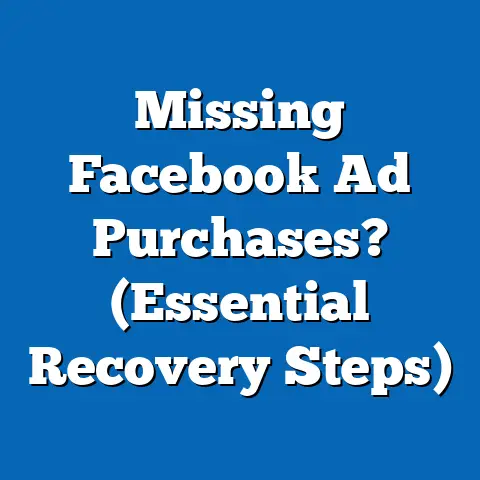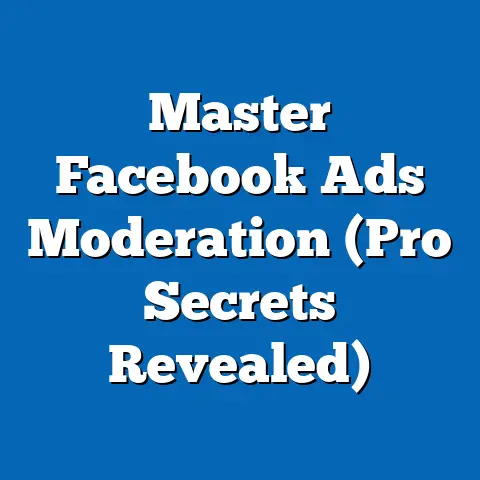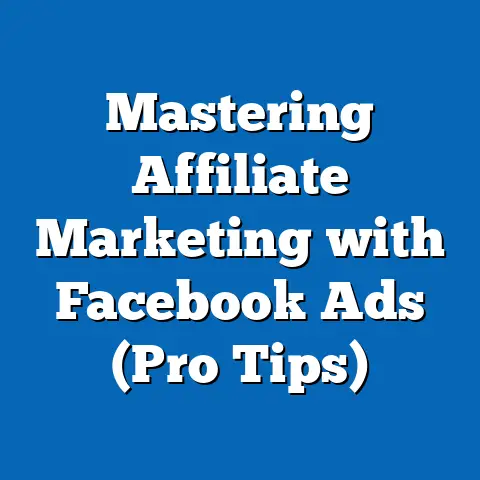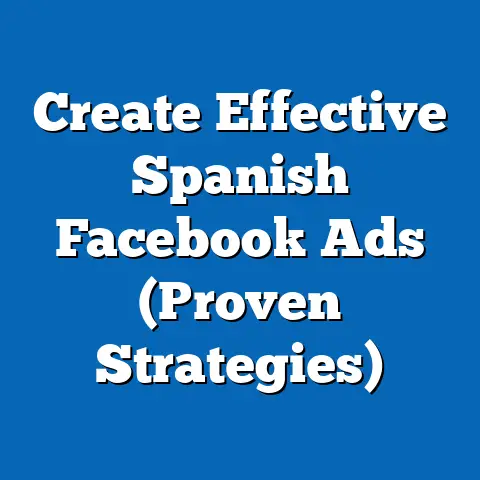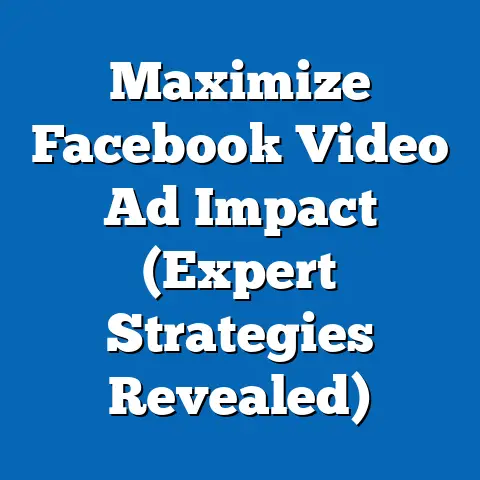Maximize Budget: Run Facebook Ads Effectively (Pro Tips)
Facebook advertising, even in today’s dynamic social media landscape, remains a powerhouse for businesses aiming to connect with their target audience. With billions of active users and granular targeting options, Facebook offers unparalleled opportunities to reach potential customers. However, simply running ads isn’t enough. To truly succeed, you need to maximize your advertising budget, ensuring every dollar contributes to achieving your business goals. This article will guide you through proven strategies and pro tips to help you make the most of your Facebook ad spend, turning clicks into customers and views into value.
I remember when I first started experimenting with Facebook ads for my own online store. I was excited about the potential reach, but quickly overwhelmed by the options and the feeling that my budget was disappearing without much to show for it. It was a steep learning curve, filled with costly mistakes and frustrating results. But through trial and error, countless hours of research, and staying on top of the ever-changing Facebook algorithm, I developed a system that consistently delivers a high ROI. Now, I’m sharing those insights with you, so you can avoid the pitfalls and start seeing real results from your Facebook ad campaigns.
Section 1: Understanding Facebook Ad Basics
Before diving into advanced strategies, it’s crucial to have a solid understanding of the fundamentals. Facebook ads are essentially paid messages that appear on the platform, designed to reach a specific audience based on demographics, interests, behaviors, and more. These ads come in various formats, each with its own strengths and use cases.
- Image Ads: Single image with accompanying text, ideal for simple messages and visual appeal.
- Video Ads: Engaging video content that captures attention and conveys a story or demonstration.
- Carousel Ads: Display multiple images or videos in a scrollable format, perfect for showcasing products or features.
- Collection Ads: Visually appealing ads that display a group of products, designed to drive sales.
- Lead Generation Ads: Collect leads directly within Facebook, simplifying the signup process for potential customers.
The Importance of Targeting:
Facebook’s targeting capabilities are what truly set it apart from other advertising platforms. You can target users based on a wide range of criteria, including:
- Demographics: Age, gender, location, education, job title, etc.
- Interests: Hobbies, passions, and topics they engage with on Facebook.
- Behaviors: Purchase history, online activity, and device usage.
- Custom Audiences: Upload your own customer list to target existing customers or create lookalike audiences.
- Lookalike Audiences: Target users who share similar characteristics to your best customers.
Identifying your ideal target audience is paramount. The more specific you are, the more relevant your ads will be, leading to higher engagement and conversion rates. I’ve seen campaigns go from zero to hero simply by refining the targeting parameters to laser-focus on the right audience.
Key Metrics to Monitor:
To measure the success of your Facebook ad campaigns, you need to track key performance indicators (KPIs). These metrics provide valuable insights into how your ads are performing and where you can make improvements.
- CTR (Click-Through Rate): The percentage of people who see your ad and click on it. A higher CTR indicates a more relevant and engaging ad.
- CPC (Cost Per Click): The amount you pay each time someone clicks on your ad. Lowering your CPC is a key goal for maximizing your budget.
- CPM (Cost Per Mille): The cost you pay for every 1,000 impressions (times your ad is shown). This is useful for measuring brand awareness campaigns.
- Conversion Rate: The percentage of people who click on your ad and complete a desired action, such as making a purchase or filling out a form.
- ROI (Return on Investment): The overall profitability of your ad campaign, calculated by dividing the revenue generated by the ad spend.
Takeaway: Understanding the basics of Facebook ads, including ad formats, targeting options, and key metrics, is essential for creating effective campaigns.
Section 2: Setting a Realistic Budget
One of the biggest mistakes I see businesses make is diving into Facebook advertising without a clear budget or strategy. It’s easy to get caught up in the excitement and overspend without seeing the desired results. Setting a realistic budget is crucial for long-term success.
Determining Your Ad Spend:
How much should you spend on Facebook ads? There’s no one-size-fits-all answer. It depends on several factors, including:
- Your Business Goals: What are you trying to achieve with your ads? Are you looking to increase brand awareness, generate leads, or drive sales?
- Your Target Audience Size: The larger your target audience, the more you’ll likely need to spend to reach them.
- Your Industry: Some industries are more competitive than others, which can drive up advertising costs.
- Your Profit Margin: How much profit do you make on each sale? This will help you determine how much you can afford to spend on advertising.
A good starting point is to allocate a percentage of your overall marketing budget to Facebook ads. Many experts recommend starting with 5-10% and adjusting based on performance. You can also choose between a daily budget (the average amount you’ll spend each day) or a lifetime budget (the total amount you’ll spend over the duration of your campaign).
Allocating Funds Wisely:
Once you’ve determined your overall budget, it’s important to allocate it wisely across different campaigns, ad sets, and ad formats. Consider these factors:
- Campaign Objectives: Allocate more budget to campaigns that are directly aligned with your business goals.
- Ad Set Performance: Monitor the performance of each ad set and reallocate budget to the ones that are generating the best results.
- Ad Format Effectiveness: Experiment with different ad formats and allocate more budget to the ones that are most engaging for your target audience.
Understanding Bidding Strategies:
Facebook offers various bidding options that allow you to control how much you pay for each ad interaction. The most common bidding strategies include:
- Lowest Cost: Facebook automatically bids to get you the most results for your budget. This is a good option for beginners.
- Cost Cap: You set a maximum cost per result, and Facebook tries to stay below that amount. This gives you more control over your spending.
- Target Cost: You set a target cost per result, and Facebook tries to achieve that average over time.
- Bid Cap: You set a maximum bid for each auction, giving you the most control over your spending.
Choosing the right bidding strategy depends on your goals and experience level. I recommend starting with “Lowest Cost” to get a feel for the platform, and then experimenting with other strategies as you become more comfortable.
Takeaway: Setting a realistic budget and allocating funds wisely are crucial for maximizing your Facebook ad spend. Experiment with different bidding strategies to find the one that works best for you.
Section 3: Crafting Compelling Ad Content
Even with the most precise targeting and a well-defined budget, your Facebook ads will fall flat if the content isn’t compelling. In a world saturated with online noise, you need to create ads that grab attention, resonate with your audience, and inspire action.
Importance of Quality Content:
Think of your Facebook ad as a miniature sales pitch. You have a limited amount of time and space to capture someone’s attention and convince them to take the next step. High-quality content is essential for:
- Grabbing Attention: A visually appealing ad with a compelling headline will stand out from the crowd.
- Building Trust: Authentic and informative content will build trust with your audience.
- Driving Engagement: Engaging content will encourage people to click, comment, and share your ad.
- Increasing Conversions: Clear and persuasive content will motivate people to take the desired action, such as making a purchase or signing up for a newsletter.
Best Practices for Ad Copy:
Writing effective ad copy is an art form. Here are some tips to help you craft compelling messages:
- Know Your Audience: Understand their needs, pain points, and desires. Speak directly to them in their language.
- Highlight Benefits, Not Just Features: Focus on how your product or service will solve their problems and improve their lives.
- Use Strong Headlines: Your headline is the first thing people will see, so make it count. Use power words, numbers, and questions to grab attention.
- Keep It Concise: People have short attention spans online. Get to the point quickly and use clear, concise language.
- Create a Sense of Urgency: Encourage people to take action now by using phrases like “Limited Time Offer” or “Shop Now.”
- Include a Clear Call-to-Action (CTA): Tell people exactly what you want them to do, such as “Shop Now,” “Learn More,” or “Sign Up.”
Visual Elements that Work:
Visuals are just as important as the text in your ad. Choose high-quality images or videos that are relevant to your message and visually appealing.
- Use High-Resolution Images: Avoid blurry or pixelated images.
- Showcase Your Product: If you’re selling a product, show it in action.
- Use Eye-Catching Colors: Choose colors that are consistent with your brand and that stand out from the Facebook feed.
- Include Branding: Make sure your brand logo is visible in your ad.
- Consider Video: Video ads are highly engaging and can be a great way to tell your story.
I’ve found that user-generated content, like customer photos and videos, often performs incredibly well because it feels more authentic and relatable.
Takeaway: Crafting compelling ad content is essential for capturing attention, building trust, and driving conversions. Focus on creating high-quality visuals and persuasive ad copy that resonates with your target audience.
Section 4: Effective Targeting and Audience Segmentation
As I mentioned earlier, Facebook’s targeting capabilities are its superpower. But wielding that power effectively requires a deep understanding of your audience and strategic use of the platform’s targeting tools.
Utilizing Facebook’s Targeting Tools:
Facebook offers a wide range of targeting options to help you reach the right people with your ads. Let’s explore some of the most effective:
- Custom Audiences: This allows you to upload your own customer list (email addresses, phone numbers, etc.) to target existing customers or create lookalike audiences. This is incredibly powerful for retargeting and nurturing relationships.
- Lookalike Audiences: Facebook will find users who share similar characteristics to your best customers. This is a great way to expand your reach and find new potential customers.
- Detailed Targeting: This allows you to target users based on their interests, behaviors, demographics, and more. This is where you can really get granular and target specific niches.
Retargeting Strategies:
Retargeting is a powerful strategy for re-engaging users who have interacted with your brand but haven’t yet converted. You can retarget users who:
- Visited Your Website: Show them ads for products they viewed or added to their cart.
- Watched Your Video: Show them ads for related products or services.
- Engaged With Your Facebook Page: Show them ads for special offers or events.
Retargeting ads are often highly effective because they’re shown to people who are already familiar with your brand.
A/B Testing for Audience Segmentation:
A/B testing (also known as split testing) is the process of testing different versions of your ads to see which one performs best. This is a crucial step for refining your audience segments and improving ad performance.
- Test Different Targeting Options: Experiment with different interests, behaviors, and demographics to see which ones generate the best results.
- Test Different Ad Creatives: Try different headlines, images, and CTAs to see which ones are most engaging.
- Test Different Bidding Strategies: Experiment with different bidding options to see which one is most cost-effective.
I always recommend running A/B tests on a regular basis to stay ahead of the curve and optimize your campaigns for maximum performance.
Takeaway: Effective targeting and audience segmentation are crucial for reaching the right people with your ads. Utilize Facebook’s targeting tools, implement retargeting strategies, and run A/B tests to refine your audience segments and improve ad performance.
Section 5: Analyzing and Optimizing Ad Performance
Running Facebook ads is not a “set it and forget it” activity. It requires ongoing monitoring, analysis, and optimization to ensure you’re getting the best possible results.
Using Facebook Ads Manager:
Facebook Ads Manager is your command center for managing and analyzing your ad campaigns. It provides a wealth of data and insights that can help you understand how your ads are performing.
- Track Key Metrics: Monitor your CTR, CPC, CPM, conversion rate, and ROI on a regular basis.
- Analyze Performance by Ad Set: See which ad sets are performing well and which ones need adjustments.
- Analyze Performance by Ad: See which ads are most engaging and which ones are falling flat.
- Use the Reporting Tools: Generate custom reports to track your progress and identify trends.
Interpreting Data:
Understanding the data in Facebook Ads Manager is crucial for making informed decisions about your campaigns.
- Low CTR: This could indicate that your ad is not relevant to your target audience or that your ad creative is not engaging.
- High CPC: This could indicate that your targeting is too broad or that your ad quality score is low.
- Low Conversion Rate: This could indicate that your landing page is not optimized for conversions or that your offer is not compelling.
Making Data-Driven Decisions:
Based on your analysis of the data, you can make adjustments to your campaigns to improve performance.
- Pause Underperforming Ads: Don’t be afraid to kill ads that are not generating results.
- Adjust Targeting: Refine your targeting parameters to reach a more relevant audience.
- Reallocate Budget: Move budget from underperforming ad sets to those that are generating the best results.
- Test New Ad Creatives: Experiment with different headlines, images, and CTAs to see what resonates with your audience.
- Optimize Landing Pages: Ensure your landing pages are optimized for conversions.
I’ve personally seen campaigns turn around completely just by making small, data-driven adjustments based on the insights provided by Facebook Ads Manager.
Takeaway: Analyzing and optimizing your ad performance is an ongoing process. Use Facebook Ads Manager to track key metrics, interpret data, and make data-driven decisions to improve your campaigns.
Section 6: Staying Updated with Facebook Ads Trends
The world of digital advertising is constantly evolving, and Facebook ads are no exception. New features, algorithm updates, and best practices are constantly emerging. To stay ahead of the curve, it’s crucial to stay updated with the latest trends.
The Evolving Landscape of Digital Advertising:
Facebook is constantly making changes to its advertising platform. These changes can impact your campaign performance, so it’s important to stay informed.
- Algorithm Updates: Facebook’s algorithm determines which ads are shown to users. Understanding how the algorithm works is crucial for optimizing your campaigns.
- New Features: Facebook regularly introduces new advertising features. Take advantage of these features to improve your campaigns.
- Policy Changes: Facebook has strict advertising policies. Make sure you’re familiar with these policies to avoid having your ads disapproved.
Utilizing Resources:
There are many resources available to help you stay updated with Facebook ads trends.
- Facebook’s Official Blog: This is a great source for information about new features, algorithm updates, and best practices.
- Industry Blogs: Follow leading marketing blogs to stay informed about the latest trends and insights.
- Webinars and Conferences: Attend webinars and conferences to learn from industry experts.
- Online Communities: Join online communities to connect with other marketers and share tips and insights.
Adapting Strategies:
The key to success with Facebook ads is to be flexible and adaptable. Don’t be afraid to experiment with new strategies and adjust your campaigns based on the latest trends.
Takeaway: Staying updated with Facebook ads trends is crucial for long-term success. Utilize available resources, adapt your strategies, and be prepared to experiment with new features and techniques.
Conclusion
Mastering Facebook advertising is an ongoing journey, but with the right knowledge and strategies, you can maximize your budget and achieve your business goals. Remember to start with a solid understanding of the basics, set a realistic budget, craft compelling ad content, target your audience effectively, analyze and optimize your performance, and stay updated with the latest trends.
By implementing the pro tips discussed in this article, you can transform your Facebook ad campaigns from cost centers to profit generators. Don’t be afraid to experiment, test new strategies, and learn from your mistakes. The key is to stay persistent, adaptable, and data-driven.
As I’ve learned through my own experiences, the core principles of effective Facebook advertising remain timeless. While the platform and techniques may evolve, the fundamentals of understanding your audience, creating compelling content, and continuously optimizing your campaigns will always be essential for success. Embrace these principles, and you’ll be well on your way to achieving long-term growth and profitability through Facebook advertising. So, take action today, implement these strategies, and start seeing the results you deserve!

